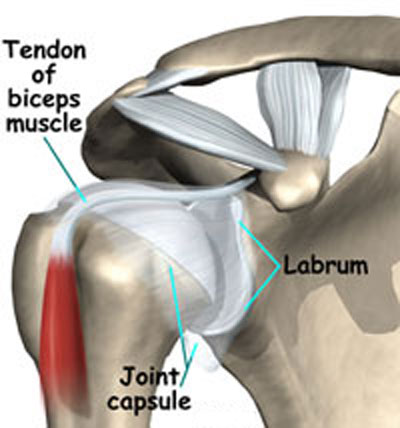The shoulder joint involves 3 bones:
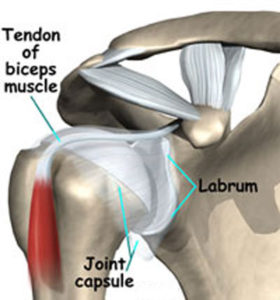
- scapula (shoulder blade)
- clavicle (collarbone)
- humerus (upper arm bone)
The head of the humerus rests in a shallow socket of the scapula called the glenoid. Since the head of the humerus is much larger than the glenoid, a soft fibrous tissue called the labrum surrounds the glenoid to help deepen and stabilize the shoulder joint. For a more detailed article on the anatomy of the shoulder, please see Shoulder Pain & Rib Cage Position.
How Does the Labrum Get Injured?
- fall on an outstretched arm
- direct blow to shoulder
- sudden pull, such as when trying to lift a heavy object or being pulled by a sudden force
- forceful overhead motions
Tears of the labrum often occur with other shoulder injuries, like when the shoulder subluxates or dislocates. The 2 classic tear patterns for the labrum are:
- Superior Labrum Anterior (front) to Posterior (back) which can involve the biceps tendon (SLAP lesion)
- inferior glenohumeral ligament tear (Bankart lesion)
Signs & Symptoms of a Labrum Tear
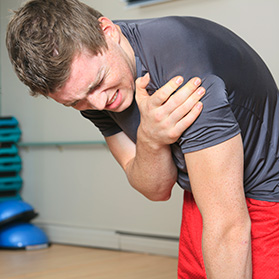 pain with overhead activity
pain with overhead activity- catching, locking, popping or grinding
- sense of instability (looseness) in the shoulder
- decreased range of motion
- loss of strength
Evaluation to Confirm a Labrum Tear
- orthopedic tests specific to the shoulder labrum
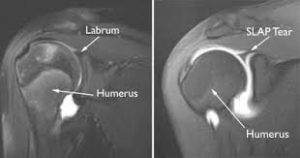
- MRI arthrogram (injected dye into the shoulder makes it easier to see small labrum tears)
- best test to confirm a labrum tear is arthroscopy
Treatment
Typically, rehabilitative efforts are attempted for shoulder labrum injuries prior to surgical intervention. This can include soft tissue therapy, physical therapy modalities and rehabilitation exercises to improve posture and position of the shoulder girdle and strengthening of the rotator cuff and surrounding musculature. If conservative measures are insufficient at decreasing shoulder pain and improving shoulder function and stability, then arthroscopic surgery can be performed.
Post-Surgical Rehabilitation of the Labrum
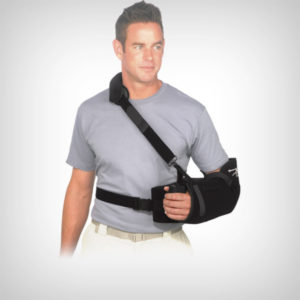 After surgery, you will need to keep your shoulder in a sling for 3-4 weeks. During this time you will be allowed to do gentle, prescribed range of motion exercises. Once the sling is removed, you will do progressive flexibility and strengthening exercises as prescribed by your therapist. Athletes can usually begin doing sports-specific exercises after 12 weeks, although it will be about 6 months before the shoulder is fully healed and ready for heavy contact such as football and hockey.
After surgery, you will need to keep your shoulder in a sling for 3-4 weeks. During this time you will be allowed to do gentle, prescribed range of motion exercises. Once the sling is removed, you will do progressive flexibility and strengthening exercises as prescribed by your therapist. Athletes can usually begin doing sports-specific exercises after 12 weeks, although it will be about 6 months before the shoulder is fully healed and ready for heavy contact such as football and hockey.
To see a detailed breakdown of the 5 phases of a 20-week rehabilitation program please see part 2 of this article (note that part 2 is geared towards healthcare practitioners).
If you have a shoulder issue that needs to be evaluated, please give us a call at 310-534-1900 or email us at info@backtofunction.com.
References:
Massachusetts General Hospital,Sports Physical Therapy Program. Shoulder Exercises for SLAP Rehabilitation Protocol.
Brigham and Women’s Hospital, Department of Rehabilitation Services. Arthroscopic Labral Repair Protocol-Type II, IV and Complex Tears.
University of Wisconsin Sports Medicine. Rehabilitation Guidelines for SLAP Lesion Repair.
mikereinold.com/clinical-examination-of-superior-labral
www.physio-pedia.com/SLAP_Lesion


